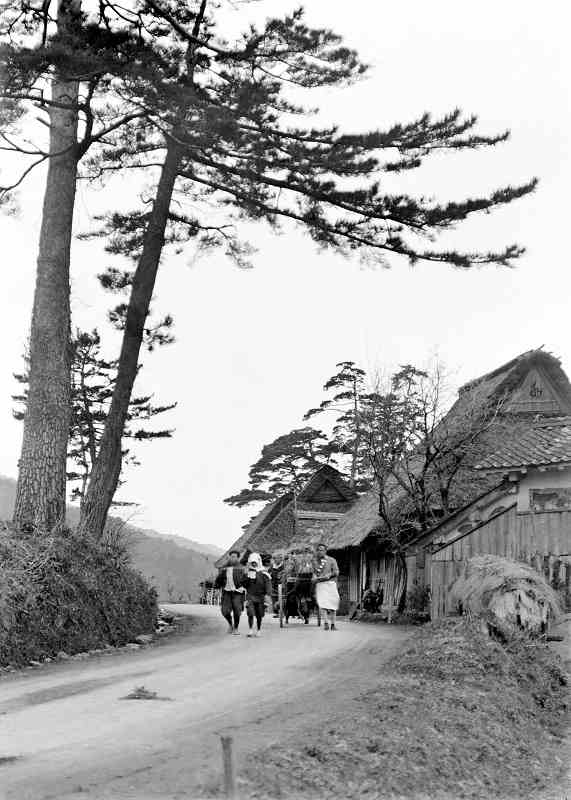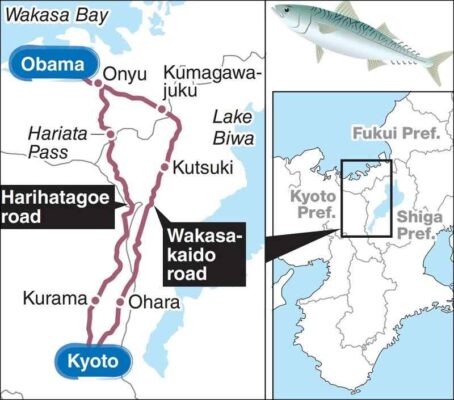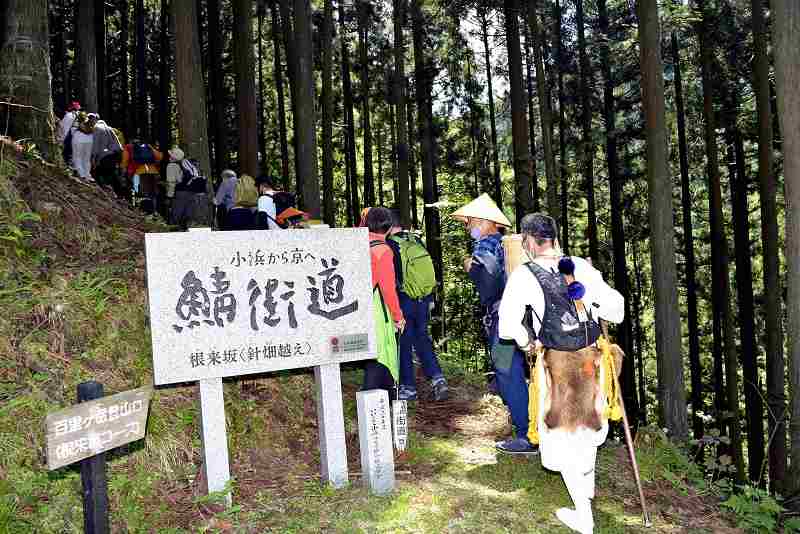
‘Saba-kaido roads’ in Meiji era (1868-1912)
9:03 JST, September 12, 2021
OBAMA, Fukui — Kyoto and Nara, the landlocked ancient capitals of Japan, once received seafood thanks to ancient food-supply routes between Kyoto and the coastal region along the Sea of Japan.
In 2015, these routes and a series of related cultural assets were recognized as a Japan Heritage site by the Cultural Affairs Agency. Work is underway to revitalize the region in Fukui Prefecture by using them.
Marine products, salt and other foodstuffs were brought to the capital from Wakasa Province, a coastal area in what is now the southern part of Fukui Prefecture, using the historical routes.

Map of the ‘Saba-kaido roads’ / Harihatagoe road, Wakasakaido road
It is said there were several such routes, collectively known as Saba-kaido roads (Mackerel roads, named thus as mackerel were one of the most popular items brought along the roads). One record stated mackerel caught in Wakasa Bay were presented to the Imperial Court over 1,200 years ago.
Of course, the route was not solely for mackerel. Peddlers brought other marine products and a variety of items unloaded by ships called Kitamae-bune, which were circling the Sea of Japan in the Edo period (1603-1867). The transactions brought about an exchange of people and cultures along the roads.
New business in old post town

Old houses are seen on a street in the Kumagawa-juku post town in Wakasa, Fukui Prefecture.
A plaque is embedded near the entrance to the Saba Kaido Museum in Obama to indicate the starting point of the roads.
The main route of the Mackerel roads is said to be the Wakasa-kaido road, which goes through the Kumagawa-juku post town, the Kutsuki area in northern Shiga Prefecture, and then to Ohara district in Kyoto.
Kumagawa-juku in what is now the town of Wakasa, Fukui Prefecture, became recognized as a post town in the 16th century. After the 17th century, during the Edo period, the district was developed as a transit point on the old highway for transporting goods to Kyoto.
From the Meiji era (1868-1912), it flourished as a shopping street. At its peak, it is said 200,000 horses carrying goods passed through the town every year. Activity in the street later declined due to the advent of railroads and cars.
A 1.1 kilometer-long street still retains a trace of the past, however, and now there is a growing trend to open new stores and accommodations in the historic post town.
An old house that stands in the center of the street, called Hishiya, was once a wholesale store built in the Meiji era. The house has been a shared office since 2018, which is run by a company owned by Sota Tokioka, 41. He moved his company from Tokyo to there.
The house, once bustling with horse-drawn transporters and people carrying loads on their backs, was vacant until it was turned into a shared office. Tokioka rented and renovated the house with the help of the Wakasa town government and other locals. Tokioka also operates lodging facilities in two other old houses.
“I’d like to revitalize this street as a local shopping district so that locals can work here,” Tokioka said.
About eight years ago, a person from Osaka opened a restaurant serving mackerel dishes along the nearby national highway. A ninja school also opened last year.

The meeting space of a shared office in a renovated old house, Hishiya
The openings have been encouraged by a group of locals, which has tried to register more and more vacant houses on a list of buildings available to potential tenants. About 30% of the 141 houses in the center of the district are vacant. The group has asked for owners to cooperate and helped prospective tenants start their lives there. A guidebook for prospective tenants was also prepared this year.
Over the past five years, more than a dozen tenants have moved into houses there.
“If the vacant houses in this post town could be sold, bought, rented or leased more flexibly, I think fewer people would leave Kumagawa,” said Tetsuo Miyamoto, head of the group.
Steep route popular among hikers
The road leading from Onyu in Obama — once the center of the Wakasa Province — over the Harihata Pass and then to Kurama in Kyoto was called the “Harihatagoe road.”
The oldest of the Mackerel roads, it is a steep route that crosses three mountain passes but it was used because it was the shortest route to Kyoto. However, it was abandoned after cars became commonplace.
In recent years, walking events in which people track the road on foot and by bus, and ultra-marathons that take a whole day to run, have become popular events along the route.
The steep road was restored by a group of mountain hikers from Obama.
Chosho Sugitani, 77, a member of the hiker group, learned about the existence of the old road from a book, and in 1971, he ventured into the mountains aiming to reach Harihata Pass. Despite difficulties with part of the road having disappeared, he finally reached the pass the following year on his third attempt.
After that, he often went into the mountains with his fellow hikers, clearing away shrubs and branches as well as wrapping tape around trees to mark the way.
Whenever they found a path deeply gouged by the traffic of ancient people, they said they were convinced it was part of the highway. It took more than 10 years to complete the work.
In 2019, signs were erected along the route, but Sugitani sees it as a problem that there are only a few people who can navigate the road.
“The road has become well-known, but I don’t think there are many Obama residents who have ever traveled on it,” he said. “If the locals don’t get excited, people from outside the prefecture won’t visit.”

Hikers walk the Harihatagoe road at an event in Obama in May. The signboard says “Saba-kaido” in large letters.
Saba Kaido Museum
The Saba Kaido Museum opened in March last year at a starting point for the Mackerel roads. It introduces the history and maps of the roads, along with the cultural assets and traditional performing arts in Obama.
The city government opened the museum across about 450 square meters of space. In the outdoor space, the two routes of the Mackerel roads — Wakasa-kaido and Harihatagoe — are re-created using mounds.
Visitors can view a map of the Mackerel roads in the one-story wooden museum, along with a basket in which peddlers are said to have carried mackerel. They can also watch a video introducing the traditional performing arts and festivals of Obama along with trick art that makes it look like visitors are on a Kitamae-bune ship.
Admission is free. The museum is open from 9 a.m. to 5 p.m., but closed every Tuesday, at the end of the year and during the New Year’s holidays.
Salted, pickled or grilled
Mackerel were transported salted, pickled or grilled during the Edo period because the fish went bad so quickly.
It is about 70 kilometers from the starting point of the highways, now Obama, Fukui Prefecture, to the end in Demachi in Kamigyo Ward, Kyoto. It takes two to three days on foot.
Carried in bamboo baskets on peddlers’ backs, the mackerel was salted just right by the time the peddlers reached Kyoto.
As the mackerel catch in Obama has significantly decreased over several decades, the city government is working on mackerel farming with private companies.
Related Tags
"Features" POPULAR ARTICLE
-

Sanrio to Open Museum in Yamanashi Pref. Dedicated to Founder, Exhibits Include Hello Kitty, Other Characters
-

Autumn Foliage Surrounds Visitors to Tokyo’s Showa Kinen Park
-

My Daughter No Longer Speaks to Me, But I Want to See Her and My Grandchild
-

Kumamoto: Public Bath Refurbished as Library Where You Can Chat, Take Photos
-

Frozen Vegetables: Demand Rises for Convenient, Tasty Domestic Produce
JN ACCESS RANKING
-

Tokyo Economic Security Forum to Hold Inaugural Meeting Amid Tense Global Environment
-

Keidanren Chairman Yoshinobu Tsutsui Visits Kashiwazaki-Kariwa Nuclear Power Plant; Inspects New Emergency Safety System
-

Imports of Rare Earths from China Facing Delays, May Be Caused by Deterioration of Japan-China Relations
-

University of Tokyo Professor Discusses Japanese Economic Security in Interview Ahead of Forum
-

Japan Pulls out of Vietnam Nuclear Project, Complicating Hanoi’s Power Plans

























